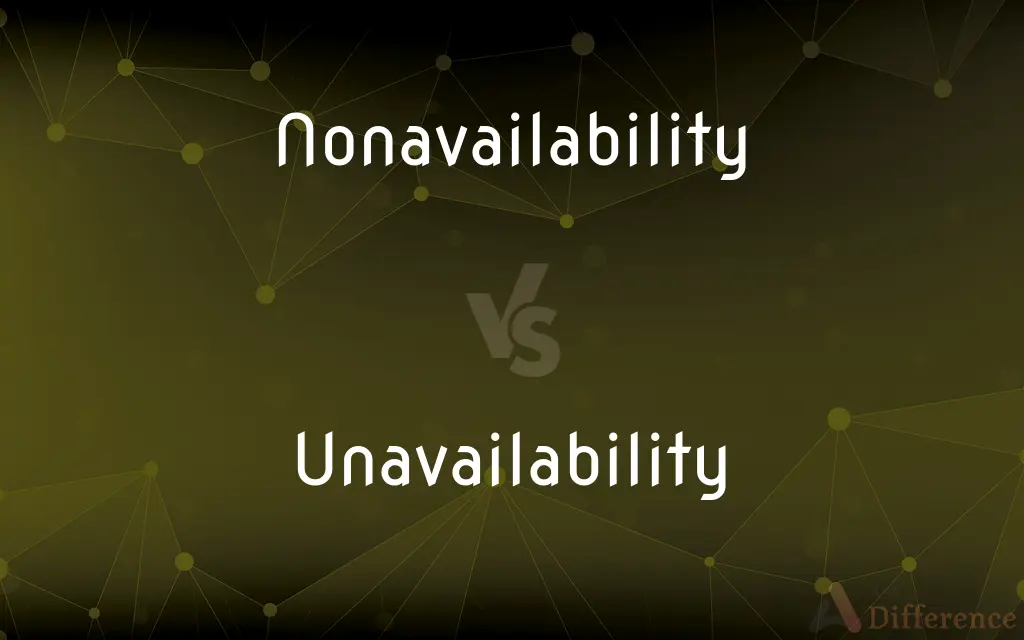Nonavailability vs. Unavailability — What's the Difference?
By Fiza Rafique & Maham Liaqat — Updated on March 21, 2024
Nonavailability often implies a lack of something due to external factors or conditions, while unavailability refers to the general state of being not available, regardless of reason.

Difference Between Nonavailability and Unavailability
Table of Contents
ADVERTISEMENT
Key Differences
Nonavailability is typically used in contexts where something is not available due to specific external constraints, such as policy or resource limitations. For example, a military base might cite nonavailability of housing for personnel due to construction. Unavailability, on the other hand, is a broader term that denotes the absence of availability, without specifying the cause. This can apply to situations ranging from an out-of-stock product to a person being unreachable.
Nonavailability suggests a temporary or conditional status, where the availability could change if the external circumstances were altered. This is common in logistical or administrative contexts. Unavailability, however, does not inherently carry implications about the duration or conditions of the availability status. It simply states that something or someone is not accessible or obtainable at the moment.
In legal and formal documents, nonavailability is often used to describe the lack of resources or services in a way that implies regulatory or systemic reasons. This usage can help in defining responsibility or eligibility based on the availability of resources. Conversely, unavailability is used in a wide range of contexts, from casual to formal, without necessarily implying a systemic cause behind the lack of availability.
The choice between nonavailability and unavailability can also reflect the speaker's perspective or the desired emphasis. Nonavailability might be chosen to highlight the role of external factors, suggesting a potential for change. Unavailability might be used to simply state a fact, without delving into the reasons behind the status.
Both terms are useful for precise communication, especially in scenarios where the distinction between temporary conditions and more indefinite states of availability is important. Understanding the subtle differences can enhance clarity, particularly in professional or technical discussions.
ADVERTISEMENT
Comparison Chart
Implication
Lack due to external factors or conditions.
General state of not being available.
Usage Context
Often specific, like logistics or policy.
Broad, applicable in various contexts.
Temporality
Implies a temporary or conditional status.
Does not imply duration or condition.
Legal and Formal
Suggests regulatory or systemic reasons.
Used broadly, without implying specific cause.
Emphasis
Highlights external factors affecting status.
States a condition without focusing on causes.
Compare with Definitions
Nonavailability
Temporary absence of availability due to specific conditions.
Nonavailability of the main hall forced the event to move outdoors.
Unavailability
The state of being not accessible or obtainable.
The unavailability of the author prevented the book signing.
Nonavailability
Lack of something due to external constraints.
The nonavailability of fresh produce in winter affects diet choices.
Unavailability
Reflects a broader, more general absence of availability.
His unavailability for comment sparked rumors.
Nonavailability
Used to denote a conditional lack of resources.
The project faced delays due to the nonavailability of key components.
Unavailability
Used in a variety of contexts, from products to people.
The doctor's unavailability led to the appointment's rescheduling.
Nonavailability
Implies potential for future availability.
The nonavailability of funds this quarter could change next.
Unavailability
Does not imply temporality or conditions for availability.
The unavailability of reliable data hindered the research.
Nonavailability
Often relates to logistical or policy restrictions.
Nonavailability of parking near the venue caused frustration among attendees.
Unavailability
Can denote a lack of availability for unspecified reasons.
Unavailability of tickets left many fans disappointed.
Nonavailability
A lack of availability.
Unavailability
Unavailability, in mathematical terms, is the probability that an item will not operate correctly at a given time and under specified conditions. It opposes availability.
Unavailability
Not available, accessible, or at hand.
Unavailability
The state of being unavailable
Unavailability
The quality of not being unavailable when needed
Common Curiosities
In what contexts is nonavailability used?
Nonavailability is commonly used in logistical, policy, or administrative contexts to denote a lack due to specific external factors.
What does nonavailability mean?
Nonavailability refers to the lack of availability due to specific external constraints or conditions.
How does the legal field use nonavailability?
In legal contexts, nonavailability often suggests regulatory or systemic reasons for the lack of resources or services.
What does the term unavailability signify in everyday language?
In everyday language, unavailability signifies that something or someone is not accessible or obtainable, without delving into specifics.
How does unavailability differ from nonavailability?
Unavailability is a broader term denoting the state of being not available, without specifying reasons, whereas nonavailability implies specific external factors or conditions.
Can nonavailability be temporary?
Yes, nonavailability often implies a temporary or conditional status, suggesting that availability could change if circumstances were altered.
Does unavailability imply a reason for the lack of availability?
No, unavailability does not imply a specific reason for the lack of availability.
Is unavailability always permanent?
No, unavailability does not inherently imply permanence, but it does not specify the duration or conditions for availability.
Can the terms nonavailability and unavailability be used interchangeably?
While they can be similar, their nuances mean they are not always interchangeable, especially where the cause or temporality of the availability status is important.
Does nonavailability always indicate a negative situation?
While it denotes a lack, nonavailability does not inherently indicate a negative situation; it may simply highlight temporary or conditional unavailability.
What impact does unavailability have on customer satisfaction?
Unavailability can negatively impact customer satisfaction, leading to frustration and potentially driving customers to seek alternatives.
Does nonavailability suggest a possible solution?
Indirectly, by highlighting external factors, nonavailability can suggest that addressing these factors could resolve the issue.
Is unavailability a broader concept than nonavailability?
Yes, unavailability is a broader, more general term compared to the more specific implications of nonavailability.
How do businesses handle nonavailability of products?
Businesses often manage nonavailability of products by offering alternatives, backordering, or updating customers on restock times.
Can unavailability be a strategic choice?
Yes, sometimes unavailability is used strategically, such as in marketing to create demand.
Share Your Discovery

Previous Comparison
Affair vs. Event
Next Comparison
Noise vs. RacketAuthor Spotlight
Written by
Fiza RafiqueFiza Rafique is a skilled content writer at AskDifference.com, where she meticulously refines and enhances written pieces. Drawing from her vast editorial expertise, Fiza ensures clarity, accuracy, and precision in every article. Passionate about language, she continually seeks to elevate the quality of content for readers worldwide.
Co-written by
Maham Liaqat













































